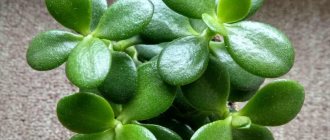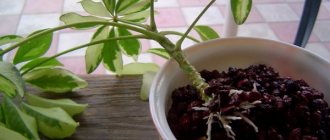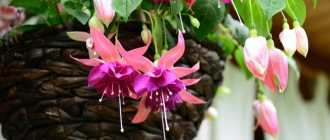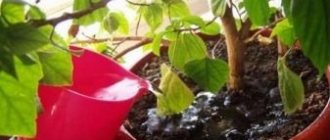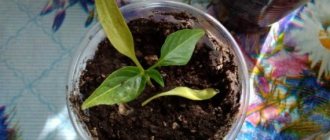Watering
The soil in the pot should always be slightly moist. In summer you have to take a watering can every 2-3 days. Croton loves moist soil. In this case, not only the top layer should be wet, but the entire lump, to the bottom. Codiaum has a developed root system that goes deep into the ground. If the roots do not have enough water, this will immediately be noticeable in the appearance of the plant: the leaves will begin to dry out. A prolonged lack of water becomes the reason why croton leaves fall off.
Excess water is no less dangerous. Typically, the danger of “flooding” a plant occurs in winter. At this time, the need for water decreases in almost all crops, as they enter a dormant period: the growth rate decreases, flowering and fruiting stop. However, the owners continue to water in the same volumes as in the summer. If there is excess moisture, the roots rot, which causes the death of the plant. Therefore, in winter they water twice as often: once every 4-6 days.
In order not to “flood” the codiaum, it is necessary to drain excess water from the cup standing under the pot. A thick layer of drainage is poured onto the bottom. This will prevent root rot. When the air temperature in the room decreases, the intensity of watering must be reduced.
Shchitovka
Shield aphids rarely attack codiaum, but you should always be prepared.
You can usually get rid of scale insects by simply removing them by hand.
Brown spots on parts of the plant are a clear example of scale insects.
For complete disinfection, treat the flower with soapy water, add 2 tablespoons of vodka to 1 liter of water and rub with a little soap.
Wipe the leaves and stems of the plant with this solution.
After that, leave it in this state for 2-3 hours, then rinse it under the shower tap.
And a few more words about leaving
In addition to what has already been said, the fertility of the soil in the pot is no less significant. Codiaum experiences a particularly acute shortage of nutrients in the summer. As for the composition, it is better to take special complexes for exotic crops. Croton transplantation is possible only once a year. But if the flower has grown a lot, then you can do it twice. But an adult plant is moved only when necessary.
Another important aspect of flower care is propagation. Cuttings are used for this. But to root the little “croton” you need to use heating and phytohormones. Although some gardeners immediately insert the leaf into a special pot and cover it with a glass jar.
Please note that codiaum should not be allowed to bloom indoors. Small light flowers collected in a brush will weaken the health of a green pet, drawing out all the vitamins and microelements from it.
Prevention
In order not to look for drugs for treatment, you need to find a suitable place for croton before purchasing and carefully study how to care for it at home. During the acclimatization period, you should not touch the codiaum, but after that it is even necessary. At this moment, it will be very timely to plant it in suitable soil: a 1:1:1 mixture - turf and leaf soil, with drainage at the bottom of the pot.
Dry air
Dry air in an apartment is a common problem during the heating season. Croton does not like dryness. Because of this, the edges of its leaves dry out. You can save a flower with a few simple measures.
- Place the pot with codiaum on a tray with damp peat, moss or expanded clay. Add water regularly. Then it will constantly evaporate, creating a more favorable microclimate.
- Sprinkle regularly. For the procedure, it is advisable to use warm water that has stood for several days. It is advisable that it be at room temperature or 1-2 degrees warmer. Before sprinkling, it is advisable to wrap the pot with film to avoid washing out the soil.
- Wipe the leafy part with a damp cloth, napkin, or sponge. This will not only moisten the croton itself and the air next to it, but will be an excellent means of combating dust accumulating on the leaf plates.
- Use special devices - humidifiers, air purifier.
At a high level of humidity, the leaves of the crop do not wither for a long time, remain bright, and do not lose turgor.
Dry air and large amounts of dust provoke various diseases and cause attacks by pests - spider mites. Due to the unfavorable microclimate, the natural immunity of codiaum is greatly reduced.
Withering
Why did the croton leaves drop? What to do?
In most cases, the reason for the wilting of croton leaves lies in the lack of lighting.
Leaves also droop when the soil gets too dry.
To cure a plant, start
watering it, but gradually.
Under no circumstances should you immediately flood the soil with water.
, since after this
the root system will begin to rot
.
To begin with, it would be a good idea to water the plant with warm water, to which you need to add Elina fertilizer.
After the soil dries, little by little
increase the volume of watering. You can also sprinkle a little water on the croton leaves.
Caring for croton at home is a painstaking and time-consuming process, and if all requirements are not met, the plant’s leaves begin to fall off. A beautiful plant with large leaves of interesting colors will give any room a completely different look.
1. I was given a croton, I don’t know what to do with it, what its habits are.
Answer:
It is advisable to transplant Croton into special soil. It's called "Codiaeum". Or ask the soil most suitable for it at a flower shop. Good watering so that the soil does not dry out too much. Bright enough light to variegate the leaves (but not direct sunlight), spray every day, and wash once a week in a lukewarm shower. Croton loves warmth and humid air, so it is advisable to buy another tray, put drainage in it and pour water, it is important that there is no water at the roots. The pot should be spacious enough, but not too big. Croton's roots are quite powerful, but when replanting, it is still advisable to look at the condition of the root system and earthen coma, because It is customary to increase the container slightly, so that there is no more than 3-4 cm between the old lump and the walls of the pot. Well, there is no need to bury it, make good drainage. Croton-karizulka! Whatever is wrong, the leaves are down and there is mortal resentment towards the owner. “...Give me a drink, I’m cold, I’m hot, it’s blowing and shining, and in general you don’t love me...” This is not a complete list of his grievances. Give him a real resort. Everything should be normal, including humidity and watering, indirect sun, washing the leaves, and of course love and markets with it during the procedures.
2. Variegated croton throws out new leaves, but does not want to change their color.
Answer:
If he began to throw out green leaves with the onset of autumn, then he clearly does not have enough light.
3. My croton is dropping its leaves. Almost the entire stem has already been exposed - except for the top.
Answer:
Check the plant for spider mites. Very often, crotons shed their leaves precisely because of this pest (subject, of course, to observing temperature and watering conditions). In addition, if this is the first winter for your croton, then it is not surprising that it sheds its leaves. He didn’t have time to adapt, he’s feeling bad, there’s not enough light and humidity. He should be under the lamp and closer to the sink. If it is on a windowsill, then the problem is the temperature; croton does not tolerate overcooling of the roots and the slightest drafts. It is not worth cutting the top, because croton is not easy to root at all; in the middle of winter it is almost impossible.
4. My Croton’s lower leaves fell off and it looked like a “palm tree.”
Answer:
Place it under the lamp on a tray with wet expanded clay. You can’t do anything with a bare stick, but the remaining leaves can still be saved. While the plant adapts, it may shed a few more leaves. In the summer, the croton will grow and the bare trunk will not be so conspicuous. If it does not branch, you can pinch the crown at the end of February - beginning of March.
5. What is the best way to root the top of the croton - in water or in the ground. And what conditions should be created (is bottom heating and lighting necessary?). And is it necessary to keep it in Epin?
Answer:
Method 1: wash the cut, dip it in root, place it in water on the radiator, carefully wrap it in a plastic bag. Ventilate once every 2 days, then spray the leaves with water and return them to the bag on the battery. Method 2: just keep it in water until it gives roots. You just need the cutting to be lignified.
6. I replanted the croton, but after a while it hung all its leaves. What to do???
Answer:
Place it under the bag - the leaves will “stand up” again. You just don’t need to fill it, it’s just a reaction to the replanting - perhaps the roots were washed or part of them was damaged. After a week, remove the bag and spray it more often at first. Although it is better to handle such capricious plants as croton without disturbing the earthen coma and spray it with epin 2 times. Otherwise it might even shed its leaves. And once he comes back to life, gradually accustom him to life without the package.
7. Rooting a croton leaf.
Answer:
This is, in principle, possible - if you need a croton leaf with roots. It will never become a tree; it is necessary to root a leaf with a cutting and a bud.
8. There are buds on the stem, but they have not sprouted for about a year. What needs to be done to wake up the kidneys?
Answer:
Any removal of a growing point stimulates branching - that is, if you remove the growing point at the top, the buds should wake up. And it’s better to keep it under the film, there’s a greater chance that you’ll still wake up. If still not, the second option is to root the top.
plant (lat. Croton)
, also known as
codiaeum (lat. Codiaeum)
or
“Joseph’s cloak
,” belongs to the genus of the Euphorbiaceae family. Nobody knows for sure what the name “croton” means, which gardeners liked more than the scientific “codiaum”, translated from Greek meaning “head”. Maybe this name comes from the name of a city in southern Italy, where Pythagoras once founded his school, or maybe in some dialect this word means “shrub”... The homeland of wild crotons are the islands of the Pacific Ocean and Northern Australia, India, as well as Southeast Asia.
The number of species in the genus varies from 17 to 1200, but in indoor culture croton flowers are represented only by variegated croton and its hybrids. The croton flower is one of the most beautiful decorative foliage indoor plants, which serves as an excellent interior decoration and, as a rule, does not take up too much space. In some countries, the croton houseplant is considered the guardian of the hearth, protecting the house from bad energy.
Why do croton leaves dry and fall off and what to do about it?
Most gardeners claim that codenium is unpretentious in care and even beginners can grow this plant. But sometimes you can observe that some or even all of its leaves turn yellow. After some time they may dry out and fall off.
The reason for this is failure to comply with one or more conditions for proper care, often caused by basic ignorance of what this representative of the tropical flora needs.
Improper watering
In most cases, when codenium has dropped its leaves, there is a failure to comply with watering rules. Like most tropical species, it likes a humid climate and adequate watering. It is especially necessary to monitor the condition of the soil in the summer: it should always be moist.
The plant will react quite quickly to dry soil - the leaves will droop, turn yellow and fall off. In the best case, only the top will remain of a beautiful crown.
To avoid this, you need to water the codenium as needed. If the plant is large, then you can “water” it a little every day. It is important to remember that the water should be at room temperature and preferably settled.
When watering croton, it is necessary to observe the measure. The soil should be moist, but the water should not stagnate. An excellent way to avoid this is to place gravel on the tray with the plant.
Moisture must enter the plant not only through the root system, but also through the leaves. The flower will gratefully accept spraying of the crown from a spray bottle. You can simply wipe the sheets with a damp sponge. If the plant is small, then in the summer it is advisable to spray the leaves from the shower at least once a month.
Important! Do not spray croton leaves in direct sunlight - this will cause them to turn yellow and fall off.
Prevention
As they say, a disease is easier to prevent than to treat. And this also applies to maintaining the condition of our green pets.
In order not to encounter such an unpleasant problem as yellowing and dropping leaves, you need to follow several recommendations:
- the plant must be provided with a sufficient amount of moisture and at the same time avoid excessive watering;
- It is important not only to moisten the soil, but also to regularly spray the plant;
- the pot must be located away from drafts;
- Croton is suitable for light soils, with good drainage, high water and air permeability;
- the size of the container should be commensurate with the volume of the root system: if the roots are too crowded, then first of all the croton begins to shed its leaves;
- do not forget about regular feeding of the plant.
Croton is a rather elegant, beautiful and variegated indoor plant that can decorate a variety of interiors. It is distinguished by an unusual coloring and shape of the leaves, because when they fall off, this immediately affects the general appearance of the plant and seriously upsets the owners of the flower.
To prevent this from happening, you should follow simple rules for caring for it - then your green pet will delight you with its spectacular appearance for many years.
What to do if croton leaves fall off, see the video below.
Codenium, also known as codiaum or croton, attracts gardeners with its wonderful crown color and good growth: in a few years it can grow to a meter in height. In addition, the flower is unpretentious in care. Perhaps the only significant problem in its cultivation is yellowing and loss of leaves, so further we will talk about how to deal with this.
Temperature
The flower is very picky about temperature conditions. When the temperature is too low, almost all life processes stop and it stops growing. Codium practically goes into suspended animation. As a result, the leaves dry out at the tips and then fall off. The process starts at +14 °C. If the croton has shed all its “plumage”, it is likely that it is already on the verge of death.
The reason why the croton dropped its leaves may be too high a temperature. If the thermometer is above +24 °C and the air is dry, then it is likely that the flower feels uncomfortable precisely because of the heat.
Temperature
Since codiaum is a tropical plant, the best air temperature for it is:
- In summer 24 o C.
- In winter 20 o C.
If the air temperature in the room drops slightly below 15 o C, then the codiaum almost stops growing, its leaves dry out, starting from the tips, until they completely fall off, and the roots begin to rot. In very hot weather with dry air, when the temperature exceeds 25 o C, the leaves become lethargic.
For the same reason, it is not advisable to expose croton to direct sunlight. Partial shade suits him best. And it must be protected from drafts.
Growing Croton from Seeds
Croton is often used for growing. Seeds lose their viability very quickly, so it is recommended to sow only freshly harvested ones. Please note that the growing process will take a lot of time, plus the varietal characteristics of the plant will most likely not be preserved if the seeds are collected from a hybrid.
- Codiaum seeds are very large; before planting, they must be kept for about half an hour in water at a temperature of 60 ºC and left for a day to swell.
- The seeding depth is 1 cm; it is better to plant immediately in separate cups, but you can also plant them in a common container at a distance of 3-5 cm.
- To germinate seeds, you need to maintain an air temperature of 22 ºC and apply bottom watering until seedlings appear.
- Plants can be planted in separate cups with a diameter of 7 cm when they have 3 leaves. Continue to care for it as an adult plant, and then transfer it to permanent pots.
Humidity
This problem is especially relevant in winter, when the heating is turned on in the rooms, which greatly dries out the air. During this period, many plants begin to suffer from lack of moisture, so they are sprayed more often in winter than in summer.
If the owner of the codiaum often disappears at work, then you should purchase an automatic air humidifier or place any container with liquid next to the pot and periodically replenish it.
Always spray with liquid at room temperature, never cold. And it is undesirable to carry out this procedure in direct sunlight, otherwise the leaves may get burned, since the drops on them will work like a magnifying glass. Once a month, wipe the leaves from accumulated dust with a damp cloth.
Another reason why you should maintain the right air humidity is insect pests. For them, the most comfortable atmosphere is dry air. Especially for spider mites. It is this that is one of the main reasons for the drying and falling of greenery.
Insolation
Lighting mode plays a big role. In direct sunlight, croton also drops its leaves. If this behavior is noticed, it is necessary to move the flower to another place, more shady and cooler. If exposure to sunlight was short-lived, the crop will quickly recover: the leaves will rise again, become elastic and strong. If the codiaum has stood under the scorching rays for a long time, then the process becomes irreversible; the plant will only have to shed the burnt foliage. Due to regular excess sun, an indoor flower may die.
Prevention measures
Proper living conditions are the best prevention against possible diseases.
Here are some simple tips to avoid leaf loss:
- it is necessary to provide the plant with a sufficient amount of water and at the same time not to overfill it;
- You need to moisten not only the soil, but also spray the leaves;
- The pot should be placed away from drafts;
- lighting should be sufficient, but not strong;
- it is important to avoid direct sunlight on the crown;
- Croton should grow in light, well-drained soil that drains water well;
- the soil should be universal and contain turf, compost, sand, peat;
- the pot must be commensurate with the root system of the plant - if there is not enough space for the roots, the leaf will deteriorate;
- you need to “feed” the plant according to the care recommendations.
Croton is easy to care for - even a novice gardener can handle it. This plant will decorate any interior thanks to the beautiful color and shape of the leaves, so the loss of each leaf affects its appearance and is very upsetting to the owner. To prevent this from happening, it is enough to follow basic care recommendations.
Control measures
To avoid the death of a plant when its leaves are dropped, certain measures must be taken. When the first fallen leaves appear, it is necessary to spray the croton. Wiping of foliage is also recommended.
Young plants need annual replanting. This procedure is carried out in early spring. Old plants can be replanted every year or every other year. The plant should be replanted into a fertile soil mixture. It should include:
- Sod land
- river sand
- Leaf ground
- Charcoal
When a plant is infected with scale insects, the foliage begins to wither and fall off. When the air is excessively dry, red spider mites often develop on the plant. This pest attacks leaf blades, which leads to the appearance of whitish spots and premature leaf fall.
In order to ensure good growth of croton, a well-lit place is necessary, which will eliminate the possibility of pale foliage. If the plant is undernourished, leaves may fall off. That is why, after purchasing a flower, it is imperative to replant it.
For this purpose, nutritious soil is used. The pot must be selected correctly. Its diameter should be several centimeters larger than the previous one. During the period of plant transplantation, it is necessary to take care of high-quality drainage. Proper care is the key to ensuring the beauty of the crop. That is why the gardener must follow all care rules.
Red spider mite
The problem you may encounter when growing croton is pests.
Cobwebs on the plant are a clear sign that the codiaum is affected by red spider mites.
The thing is that during normal growth the plant secretes a special milky sap, which serves as protection against this pest.
But if its growth conditions are too dry, this sap is not released in sufficient quantities and the plant is endangered.
In order to rid Croton of such a sore, you need to treat it three times with products like Neoron, Actellik, etc. with a break of 7 days.
Deficiency of any substances
Another reason why the tips of croton leaf blades dry out. Over time, nutrients are removed from the soil. If the flower does not have enough of them, it will begin to wither. At the same time, the leaves can dry out in different ways: appear in spots, like a small rash or large lesions, evenly turn yellow or just start to emerge from the edges, become thin and brittle, like parchment. It depends on what elements the plant lacks. If all conditions meet the requirements of croton, then it is likely that the problem lies precisely in a deficiency of some substances; fertilizing or replanting in fresh soil is required.
Change of plant color
Why do croton leaves turn yellow? If the flower has changed color, this may indicate insufficient lighting.
Croton requires quite a lot of light, but still it is better not to place it in direct sunlight, since due to burning of the leaves, the plant also loses its former color and begins to turn unnaturally yellow.
How can you tell if codiaum has too much light? Brown spots will begin to appear on the leaves of the flowerpot.
If the plant does not turn yellow, but simply fades, it means that it most likely lacks microelements in the soil, especially nitrogen.
Why does croton have green leaves? This may be due to the fact that the plant is young.
In this case, you should provide the croton with good feeding.

